engine oil Lexus LC500 2021 Owner's Manual / LEXUS 2021 LC500,LC500H OWNER'S MANUAL (OM11559U)
[x] Cancel search | Manufacturer: LEXUS, Model Year: 2021, Model line: LC500, Model: Lexus LC500 2021Pages: 448, PDF Size: 14.11 MB
Page 1 of 448
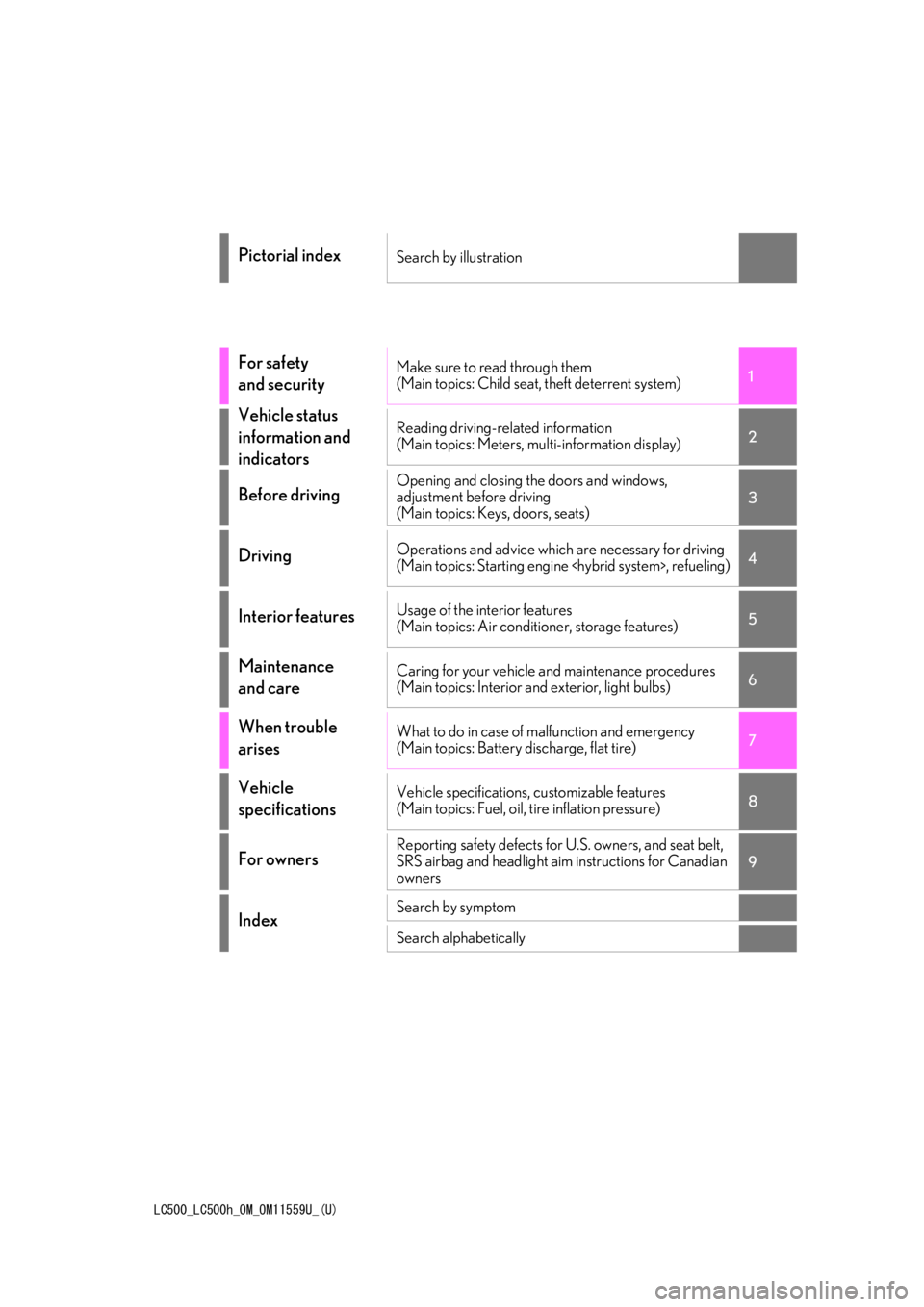
LC500_LC500h_OM_OM11559U_(U)
1
2
3
4
5
6
7
8
9
Pictorial indexSearch by illustration
For safety
and securityMake sure to read through them
(Main topics: Child seat, theft deterrent system)
Vehicle status
information and
indicatorsReading driving-related information
(Main topics: Meters, multi-information display)
Before drivingOpening and closing the doors and windows,
adjustment before driving
(Main topics: Keys, doors, seats)
DrivingOperations and advice which are necessary for driving
(Main topics: Starting engine
Interior featuresUsage of the interior features
(Main topics: Air conditioner, storage features)
Maintenance
and careCaring for your vehicle and maintenance procedures
(Main topics: Interior and exterior, light bulbs)
When trouble
arisesWhat to do in case of malfunction and emergency
(Main topics: Battery discharge, flat tire)
Vehicle
specificationsVehicle specifications, customizable features
(Main topics: Fuel, oil, tire inflation pressure)
For ownersReporting safety defects for U.S. owners, and seat belt,
SRS airbag and headlight aim instructions for Canadian
owners
IndexSearch by symptom
Search alphabetically
Page 4 of 448
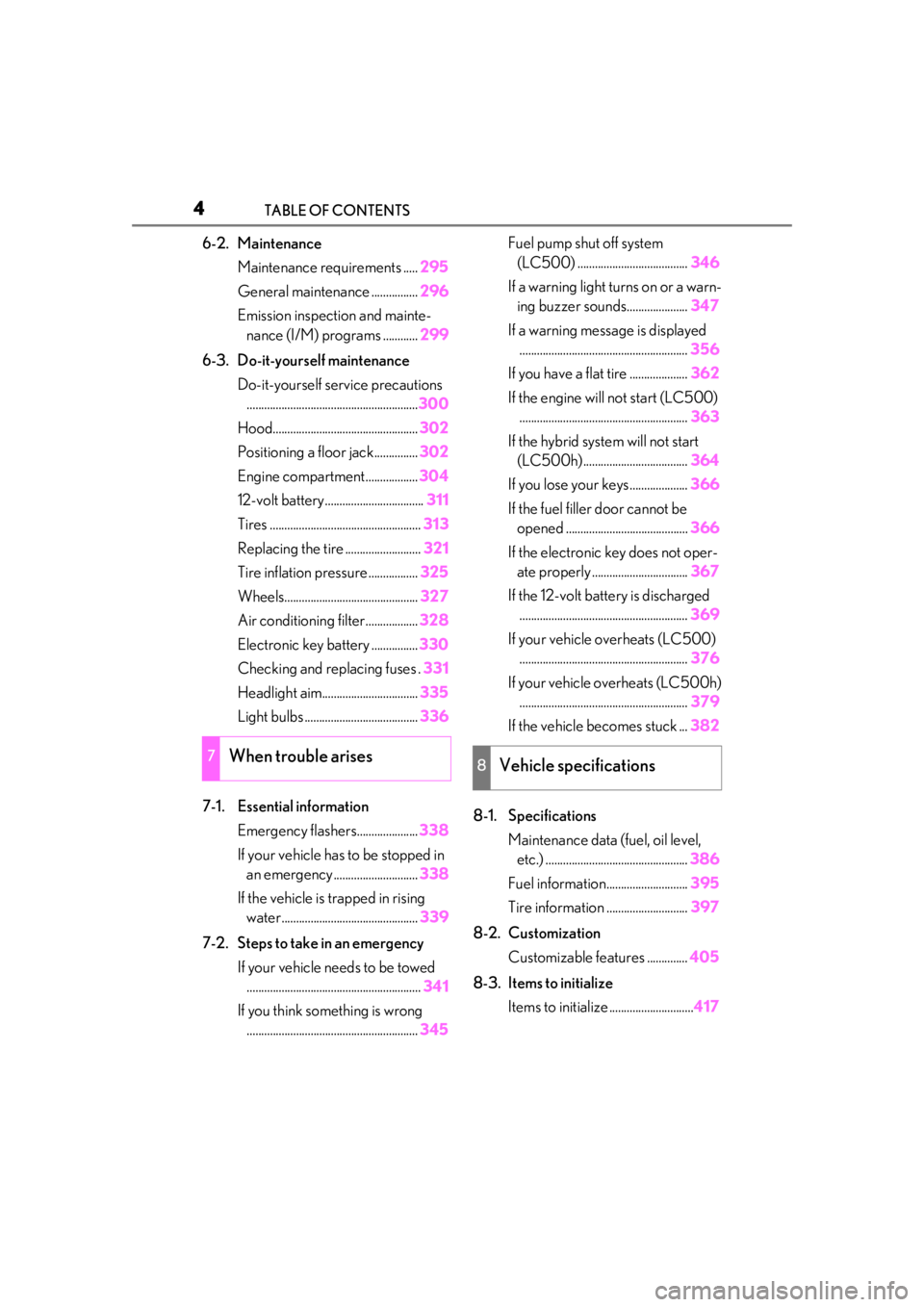
4TABLE OF CONTENTS
6-2. MaintenanceMaintenance requirements ..... 295
General maintenance ................ 296
Emission inspection and mainte- nance (I/M) programs ............ 299
6-3. Do-it-yourself maintenance Do-it-yourself service precautions........................................................... 300
Hood.................................................. 302
Positioning a floor jack............... 302
Engine compartment.................. 304
12-volt battery.................................. 311
Tires .................................................... 313
Replacing the tire .......................... 321
Tire inflation pressure ................. 325
Wheels.............................................. 327
Air conditioning filter..................328
Electronic key battery ................ 330
Checking and replacing fuses . 331
Headlight aim................................. 335
Light bulbs ....................................... 336
7-1. Essential information Emergency flashers..................... 338
If your vehicle has to be stopped in an emergency ............................. 338
If the vehicle is trapped in rising water............................................... 339
7-2. Steps to take in an emergency If your vehicle needs to be towed............................................................ 341
If you think something is wrong ........................................................... 345Fuel pump shut off system
(LC500) ...................................... 346
If a warning light turns on or a warn- ing buzzer sounds..................... 347
If a warning messa ge is displayed
.......................................................... 356
If you have a flat tire .................... 362
If the engine will not start (LC500) .......................................................... 363
If the hybrid syst em will not start
(LC500h).................................... 364
If you lose your keys.................... 366
If the fuel filler door cannot be opened .......................................... 366
If the electronic key does not oper- ate properly ................................. 367
If the 12-volt battery is discharged .......................................................... 369
If your vehicle overheats (LC500) .......................................................... 376
If your vehicle overheats (LC500h) .......................................................... 379
If the vehicle becomes stuck ... 382
8-1. Specifications Maintenance data (fuel, oil level, etc.) ................................................. 386
Fuel information............................ 395
Tire information ............................ 397
8-2. Customization Customizable features .
.............405
8-3. Items to initialize Items to initialize ............................. 417
7When trouble arises8Vehicle specifications
Page 13 of 448
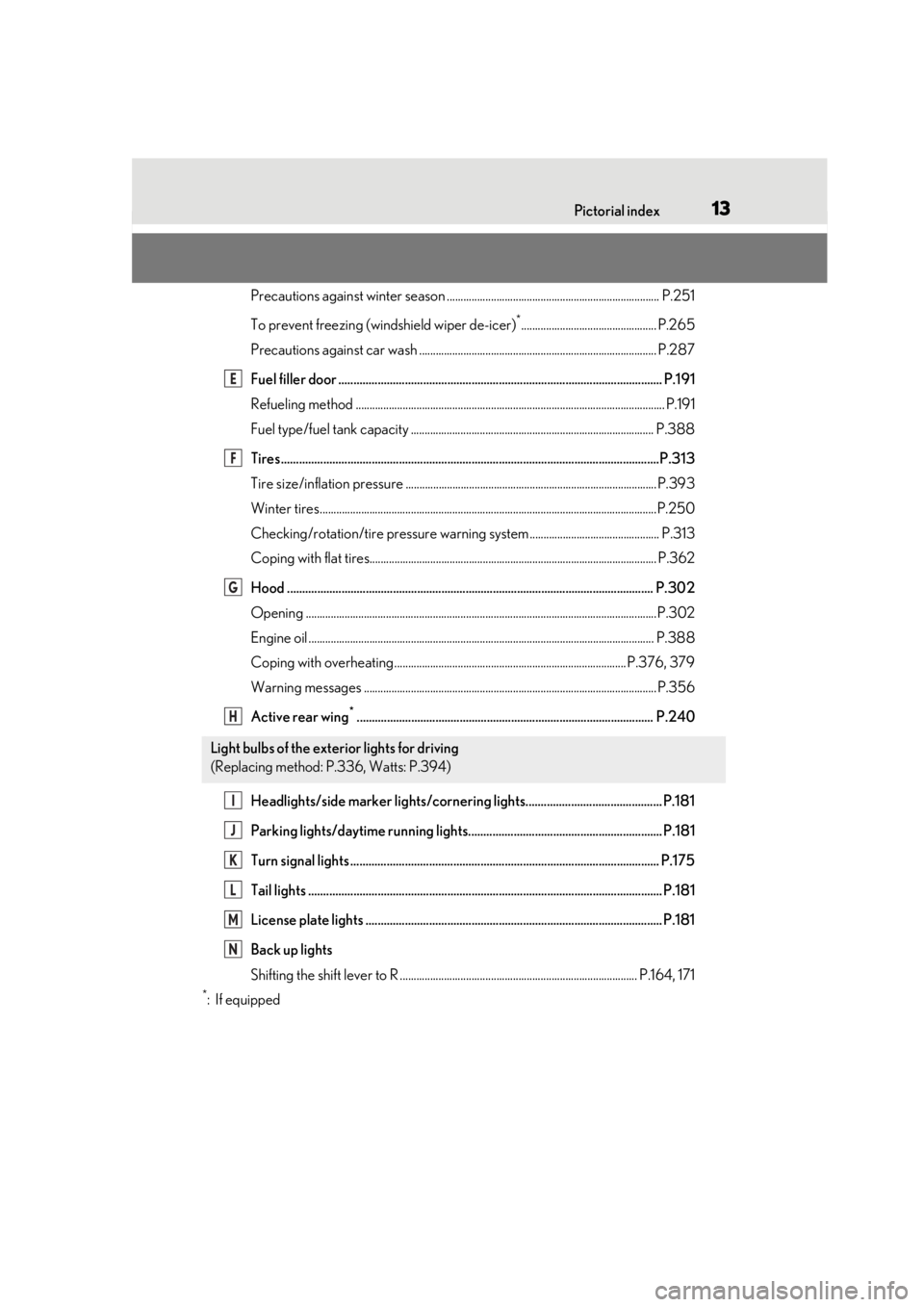
13Pictorial index
Precautions against winter season ............................................................................. P.251
To prevent freezing (windshield wiper de-icer)
*................................................. P.265
Precautions against car wash ............................. ......................................................... P.287
Fuel filler door ........................................................................................................... P.19 1
Refueling method ............................................................................................................... .P.191
Fuel type/fuel tank capacity ...... .................................................................................. P.388
Tires.......................................................................................................................... ...P.313
Tire size/inflation pressure ........................................................................................... P.393
Winter tires..........................................................................................................................P.250
Checking/rotation/tire pressure warning system............................................... P.313
Coping with flat tires........................................................................................................ P .362
Hood ......................................................................................................................... P. 302
Opening ........................................................................................................................ .......P.302
Engine oil ..................................................................................................................... ........ P.388
Coping with overheating .................................................................................... P.376, 379
Warning messages .......................................................................................................... P.356
Active rear wing
*.................................................................................................. P.240
Headlights/side marker lights/cornering lights............................................. P.181
Parking lights/daytime running lights................................................................ P.181
Turn signal lights ...................................................................................................... P.175
Tail lights .................................................................................................................... .P.181
License plate lights .................................................................................................. P.181
Back up lights
Shifting the shift lever to R .............................. ........................................................ P.164, 171
*:If equipped
Light bulbs of the exterior lights for driving
(Replacing method: P.336, Watts: P.394)
E
F
G
H
I
J
K
L
M
N
Page 77 of 448
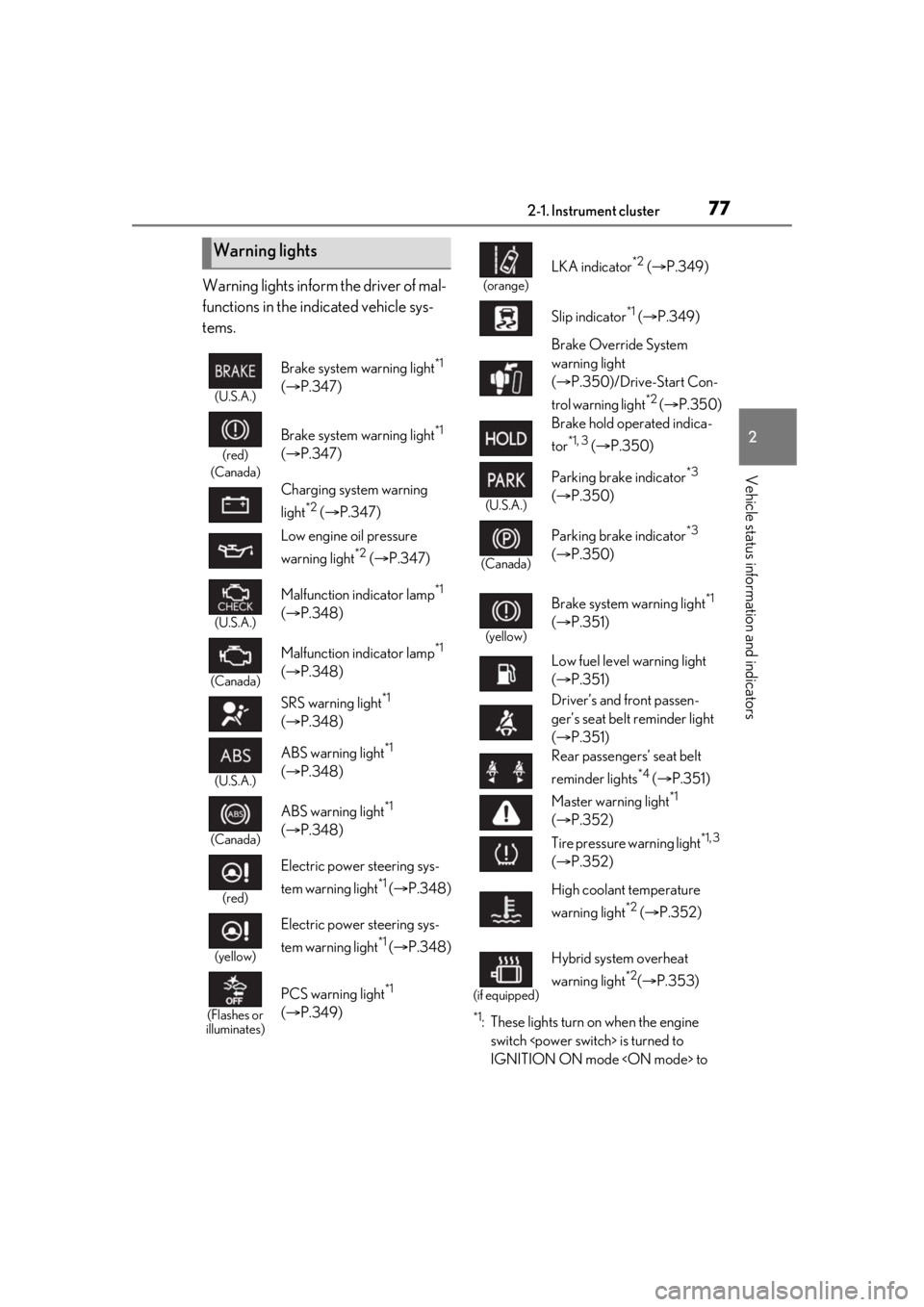
772-1. Instrument cluster
2
Vehicle status information and indicators
Warning lights inform the driver of mal-
functions in the indicated vehicle sys-
tems.
*1: These lights turn on when the engine switch
IGNITION ON mode
Warning lights
(U.S.A.)
Brake system warning light*1
( P.347)
(red)
(Canada)
Brake system warning light*1
( P.347)
Charging system warning
light
*2 ( P.347)
Low engine oil pressure
warning light
*2 ( P.347)
(U.S.A.)
Malfunction indicator lamp*1
( P.348)
(Canada)
Malfunction indicator lamp*1
( P.348)
SRS warning light
*1
( P.348)
(U.S.A.)
ABS warning light*1
( P.348)
(Canada)
ABS warning light*1
( P.348)
(red)
Electric power steering sys-
tem warning light
*1 ( P.348)
(yellow)
Electric power steering sys-
tem warning light
*1 ( P.348)
(Flashes or
illuminates)
PCS warning light*1
( P.349)
(orange)
LKA indicator*2 ( P.349)
Slip indicator
*1 ( P.349)
Brake Override System
warning light
( P.350)/Drive-Start Con-
trol warning light
*2 ( P.350)
Brake hold operated indica-
tor
*1, 3 ( P.350)
(U.S.A.)
Parking brake indicator*3
( P.350)
(Canada)
Parking brake indicator*3
( P.350)
(yellow)
Brake system warning light*1
( P.351)
Low fuel level warning light
( P.351)
Driver’s and front passen-
ger’s seat belt reminder light
( P.351)
Rear passengers’ seat belt
reminder lights
*4 ( P.351)
Master warning light
*1
( P.352)
Tire pressure warning light
*1, 3
( P.352)
High coolant temperature
warning light
*2 ( P.352)
(if equipped)
Hybrid system overheat
warning light
*2( P.353)
Page 82 of 448
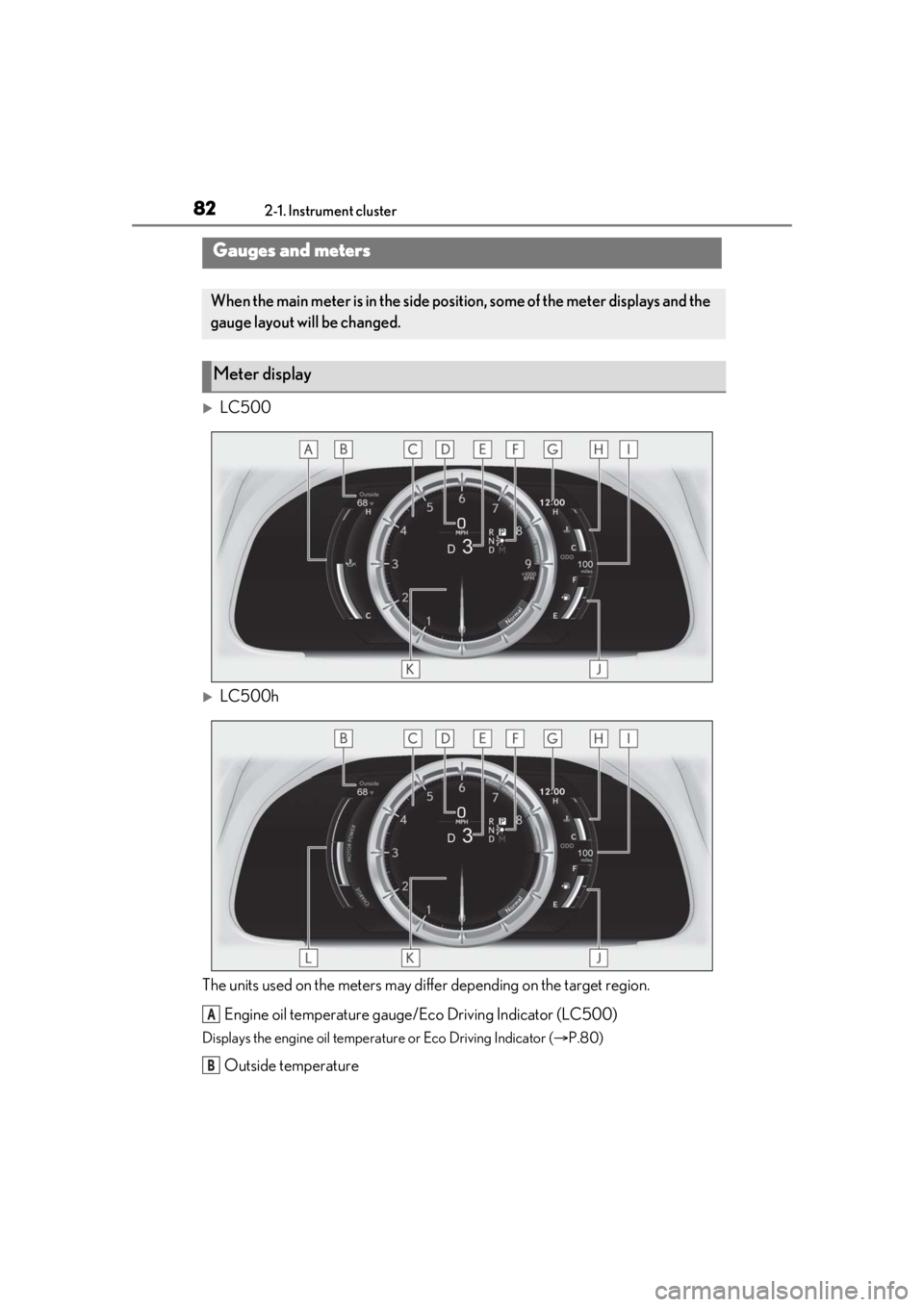
822-1. Instrument cluster
LC500
LC500h
The units used on the meters may diff er depending on the target region.
Engine oil temperature gauge/Eco Driving Indicator (LC500)
Displays the engine oil temperat ure or Eco Driving Indicator (P.80)
Outside temperature
Gauges and meters
When the main meter is in the side posi tion, some of the meter displays and the
gauge layout will be changed.
Meter display
A
B
Page 85 of 448
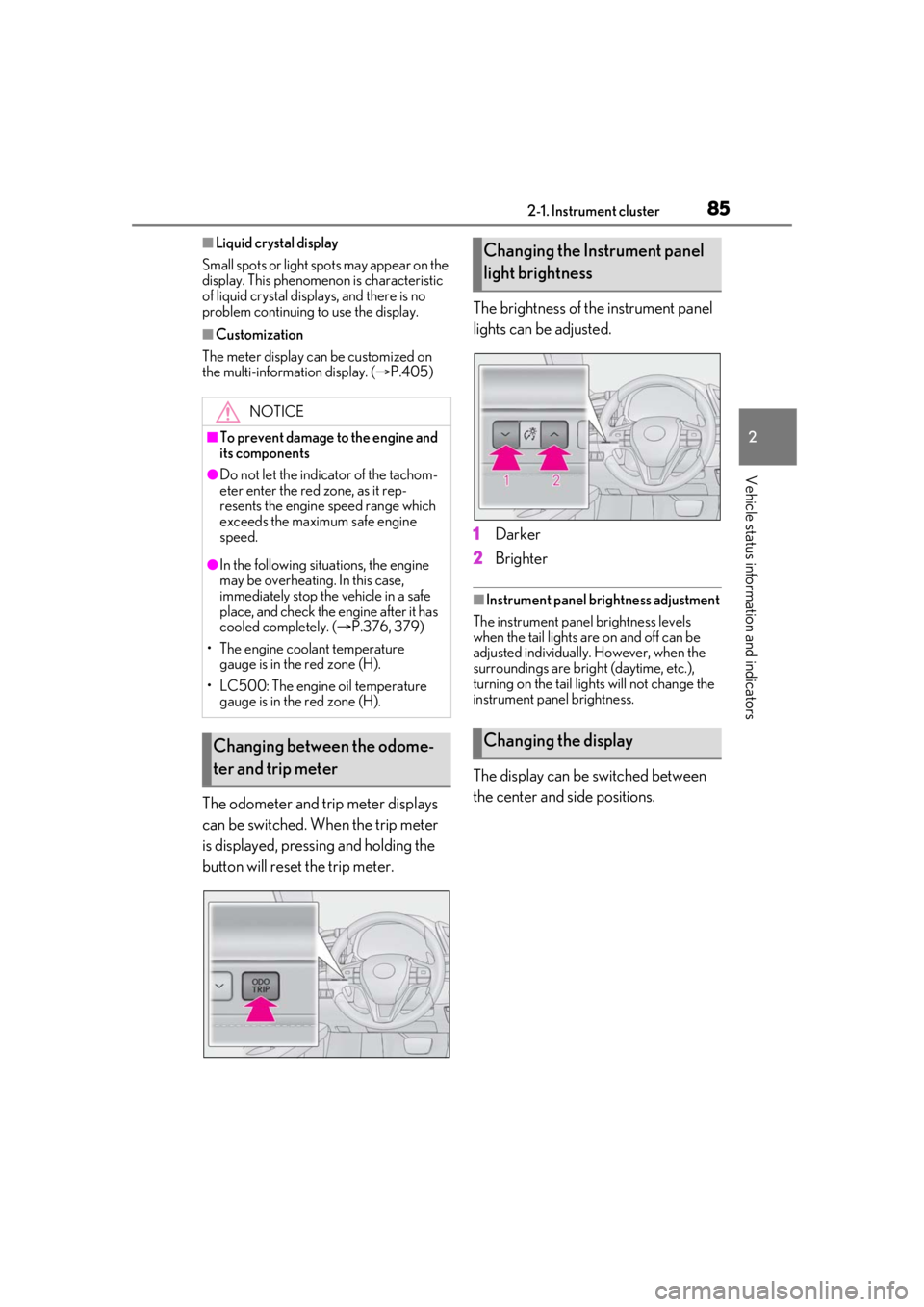
852-1. Instrument cluster
2
Vehicle status information and indicators
■Liquid crystal display
Small spots or light spots may appear on the
display. This phenomenon is characteristic
of liquid crystal displays, and there is no
problem continuing to use the display.
■Customization
The meter display can be customized on
the multi-information display. ( P.405)
The odometer and trip meter displays
can be switched. When the trip meter
is displayed, pressing and holding the
button will reset the trip meter. The brightness of the instrument panel
lights can be adjusted.
1
Darker
2 Brighter
■Instrument panel brightness adjustment
The instrument panel brightness levels
when the tail lights are on and off can be
adjusted individually. However, when the
surroundings are bright (daytime, etc.),
turning on the tail lights will not change the
instrument pa nel brightness.
The display can be switched between
the center and side positions.
NOTICE
■To prevent damage to the engine and
its components
●Do not let the indicator of the tachom-
eter enter the red zone, as it rep-
resents the engine speed range which
exceeds the maximum safe engine
speed.
●In the following situations, the engine
may be overheating. In this case,
immediately stop the vehicle in a safe
place, and check the engine after it has
cooled completely. ( P.376, 379)
• The engine coolant temperature gauge is in the red zone (H).
• LC500: The engine oil temperature gauge is in the red zone (H).
Changing between the odome-
ter and trip meter
Changing the Instrument panel
light brightness
Changing the display
Page 88 of 448

882-1. Instrument cluster
hands-free system, refer to “NAVI-
GATION SYSTEM OWNER’S
MANUAL”.
■Content of drive information
Select to display various drive data.
Up to 2 of the following items can be
selected.
Items displayed can be switched by
pressing or of the meter con-
trol switches to select and pressing or .
Current fuel consumption
*1
Displays the current rate of fuel consump-
tion
Average fuel economy (after
reset
*2/after start/after refuel)*1
Displays the average fuel consumption
since the function was reset, the engine
cle was refueled, respectively
Use the displayed average fuel consump-
tion as a reference.
Average speed (after reset*2/after
start)
*1
Displays the average vehicle speed since
the function was reset and the engine
Elapsed time (after reset*2/after
start)
*1
Displays the elapsed time since the func-
tion was reset and th e engine
Distance (range/after start)*1
Displays the estimated maximum distance
that can be driven with the quantity of fuel
remaining and the distan ce driven after the
engine
respectively.
• This distance is computed based on your average fuel consumption. As a result,
the actual distance that can be driven
may differ from that displayed.
• When only a small amount of fuel is added to the tank, the display may not be
updated.
When refueling, turn the engine switch
eled without turning the engine switch
be updated.
*1: Displayed when the it em is set in “Drive
Info 1” and “Drive Info 2”.
*2: The function can be reset by pressing “OK” of the meter control switches for
longer than 1 second when the item to
reset is displayed.
If there is more than one item that can
be reset, the item selection screen will
appear.
■Eco Driving Indicator/engine oil
temperature gauge (LC500)
P.80, 82
■Hybrid System Indicator/motor
power display (LC500h)
P.80
■Energy monitor (LC500h)
P.98
■Tire pressure
P.315
■Gear positions
Displays the current shift range or gear
position when the shift position is in D
Drive information
Page 119 of 448
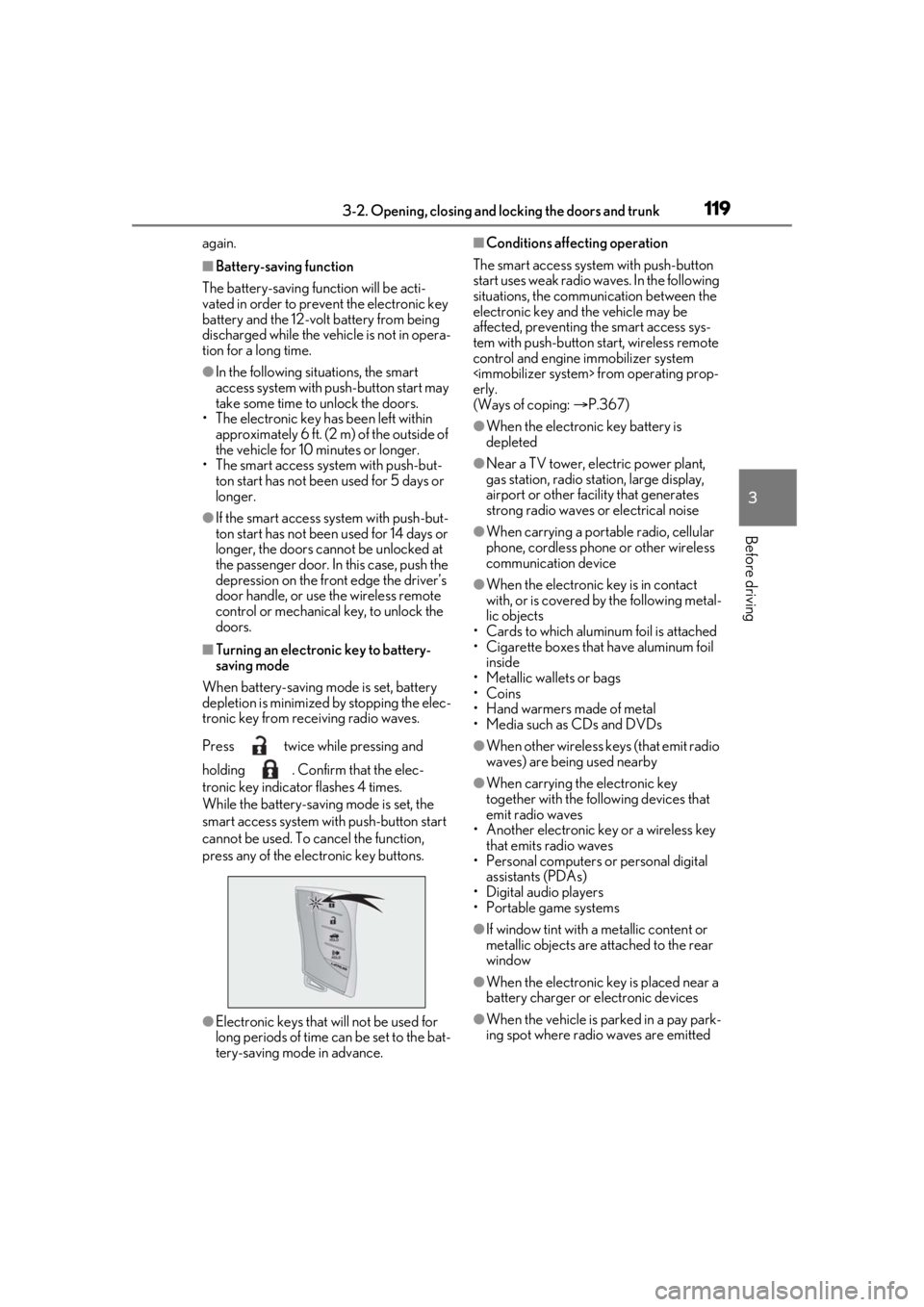
1193-2. Opening, closing and locking the doors and trunk
3
Before driving
again.
■Battery-saving function
The battery-saving fu nction will be acti-
vated in order to prevent the electronic key
battery and the 12-volt battery from being
discharged while the vehicle is not in opera-
tion for a long time.
●In the following situations, the smart
access system with pu sh-button start may
take some time to unlock the doors.
• The electronic key has been left within
approximately 6 ft. (2 m) of the outside of
the vehicle for 10 minutes or longer.
• The smart access system with push-but-
ton start has not been used for 5 days or
longer.
●If the smart access system with push-but-
ton start has not been used for 14 days or
longer, the doors cannot be unlocked at
the passenger door. In this case, push the
depression on the front edge the driver’s
door handle, or use the wireless remote
control or mechanical key, to unlock the
doors.
■Turning an electronic key to battery-
saving mode
When battery-saving mode is set, battery
depletion is minimized by stopping the elec-
tronic key from re ceiving radio waves.
Press twice while pressing and
holding . Confirm that the elec-
tronic key indicator flashes 4 times.
While the battery-saving mode is set, the
smart access system with push-button start
cannot be used. To cancel the function,
press any of the electronic key buttons.
●Electronic keys that will not be used for
long periods of time can be set to the bat-
tery-saving mode in advance.
■Conditions affecting operation
The smart access system with push-button
start uses weak radio waves. In the following
situations, the communication between the
electronic key and the vehicle may be
affected, preventing the smart access sys-
tem with push-button start, wireless remote
control and engine immobilizer system
erly.
(Ways of coping: P.367)
●When the electronic key battery is
depleted
●Near a TV tower, electric power plant,
gas station, radio stat ion, large display,
airport or other fac ility that generates
strong radio waves or electrical noise
●When carrying a portable radio, cellular
phone, cordless phone or other wireless
communication device
●When the electronic key is in contact
with, or is covered by the following metal-
lic objects
• Cards to which aluminum foil is attached
• Cigarette boxes that have aluminum foil inside
• Metallic wallets or bags
•Coins
• Hand warmers made of metal
• Media such as CDs and DVDs
●When other wireless keys (that emit radio
waves) are being used nearby
●When carrying the electronic key
together with the following devices that
emit radio waves
• Another electronic key or a wireless key that emits radio waves
• Personal computers or personal digital
assistants (PDAs)
• Digital audio players
• Portable game systems
●If window tint with a metallic content or
metallic objects are attached to the rear
window
●When the electronic key is placed near a
battery charger or electronic devices
●When the vehicle is parked in a pay park-
ing spot where radio waves are emitted
Page 148 of 448
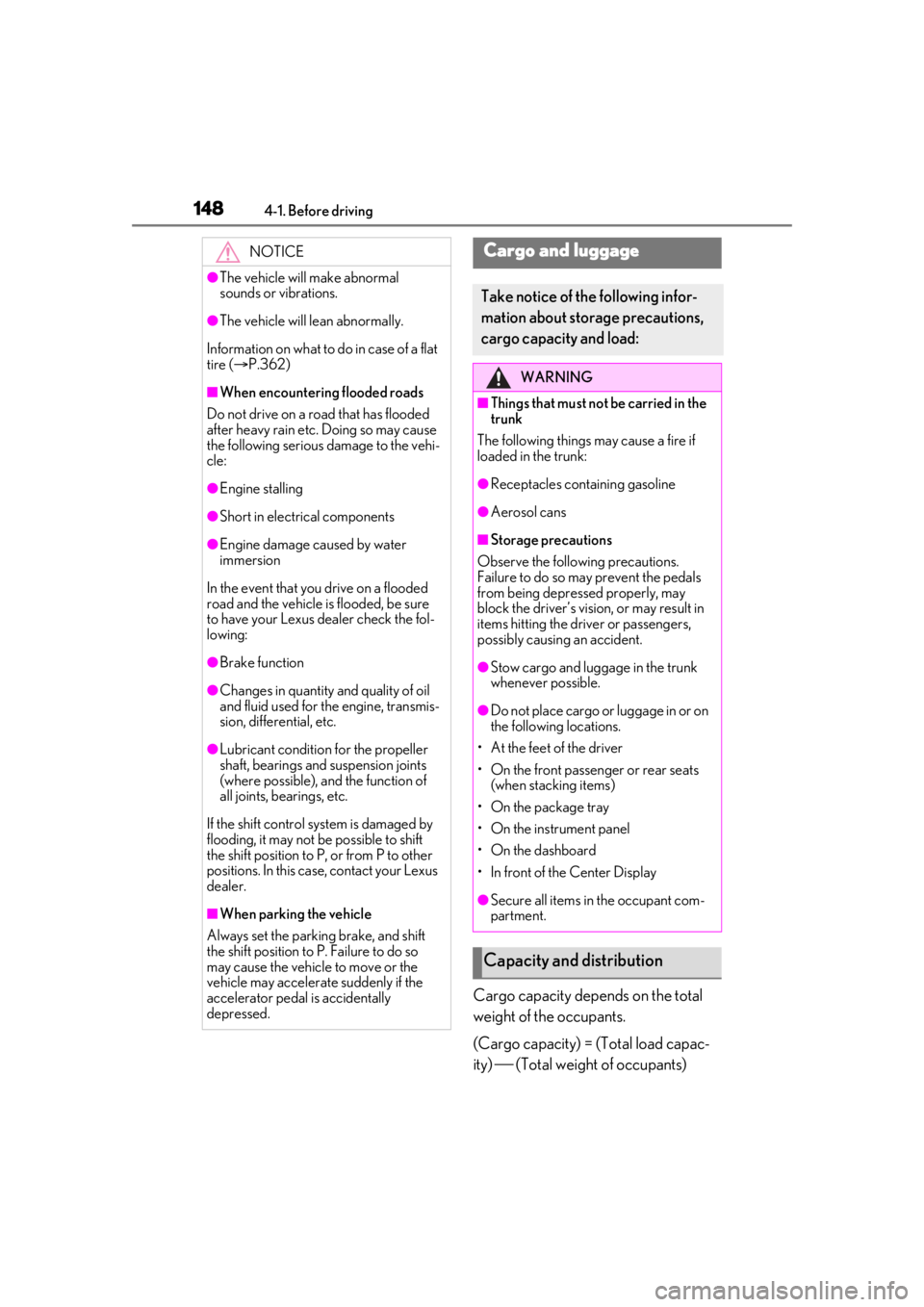
1484-1. Before driving
Cargo capacity depends on the total
weight of the occupants.
(Cargo capacity) = (Total load capac-
ity) (Total weight of occupants)
NOTICE
●The vehicle will make abnormal
sounds or vibrations.
●The vehicle will lean abnormally.
Information on what to do in case of a flat
tire ( P.362)
■When encountering flooded roads
Do not drive on a road that has flooded
after heavy rain etc. Doing so may cause
the following serious damage to the vehi-
cle:
●Engine stalling
●Short in electrical components
●Engine damage caused by water
immersion
In the event that you drive on a flooded
road and the vehicle is flooded, be sure
to have your Lexus dealer check the fol-
lowing:
●Brake function
●Changes in quantity and quality of oil
and fluid used for the engine, transmis-
sion, differential, etc.
●Lubricant condition for the propeller
shaft, bearings and suspension joints
(where possible), and the function of
all joints, bearings, etc.
If the shift control system is damaged by
flooding, it may not be possible to shift
the shift position to P, or from P to other
positions. In this case, contact your Lexus
dealer.
■When parking the vehicle
Always set the parking brake, and shift
the shift position to P. Failure to do so
may cause the vehicle to move or the
vehicle may accelerate suddenly if the
accelerator pedal is accidentally
depressed.
Cargo and luggage
Take notice of the following infor-
mation about storage precautions,
cargo capacity and load:
WARNING
■Things that must not be carried in the
trunk
The following things may cause a fire if
loaded in the trunk:
●Receptacles containing gasoline
●Aerosol cans
■Storage precautions
Observe the following precautions.
Failure to do so may prevent the pedals
from being depressed properly, may
block the driver’s vision, or may result in
items hitting the driver or passengers,
possibly causing an accident.
●Stow cargo and luggage in the trunk
whenever possible.
●Do not place cargo or luggage in or on
the following locations.
• At the feet of the driver
• On the front passenger or rear seats (when stacking items)
• On the package tray
• On the instrument panel
•On the dashboard
• In front of the Center Display
●Secure all items in the occupant com-
partment.
Capacity and distribution
Page 250 of 448
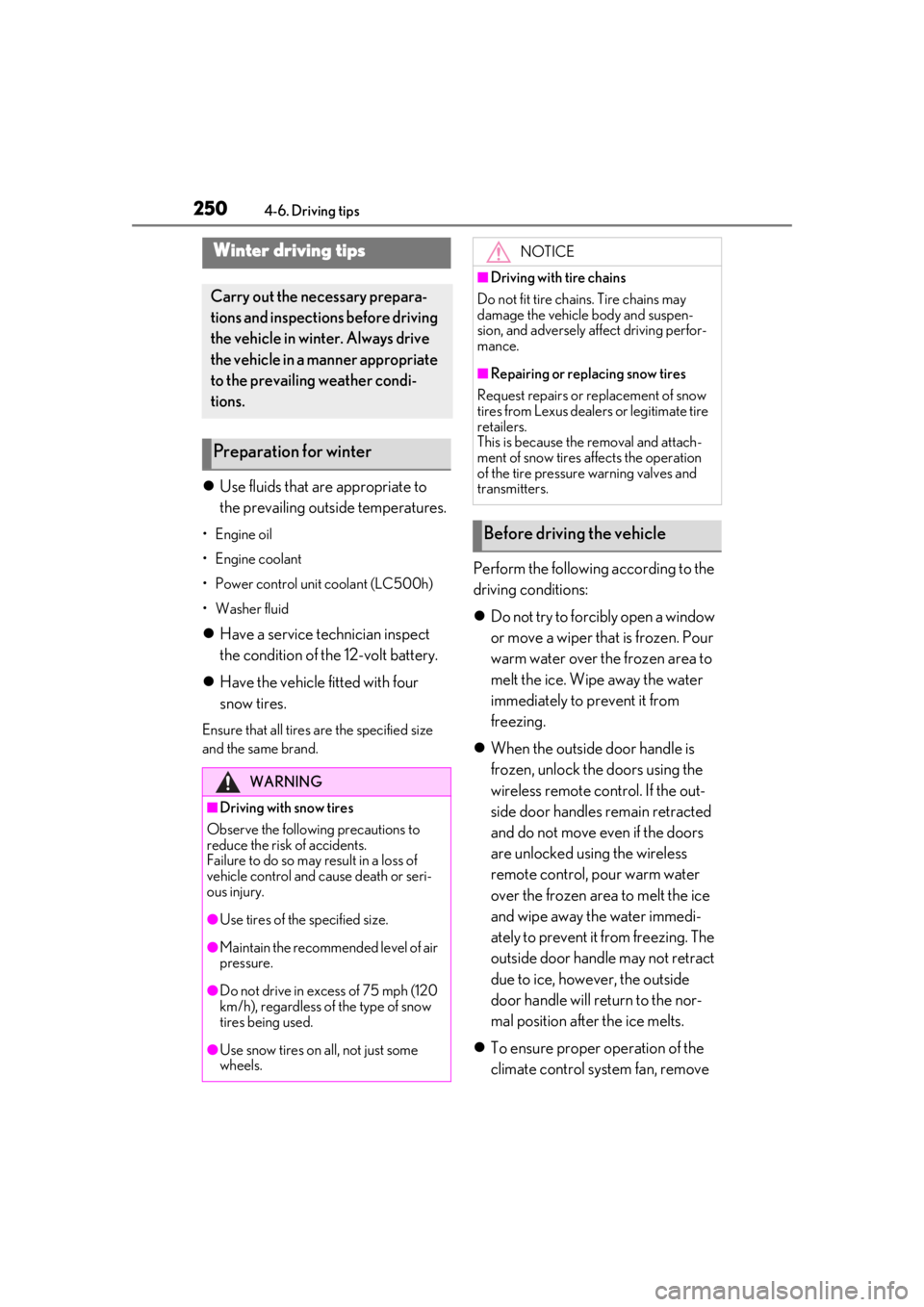
2504-6. Driving tips
Use fluids that are appropriate to
the prevailing outside temperatures.
•Engine oil
• Engine coolant
• Power control unit coolant (LC500h)
•Washer fluid
Have a service technician inspect
the condition of the 12-volt battery.
Have the vehicle fitted with four
snow tires.
Ensure that all tires are the specified size
and the same brand.
Perform the following according to the
driving conditions:
Do not try to forcibly open a window
or move a wiper that is frozen. Pour
warm water over the frozen area to
melt the ice. Wipe away the water
immediately to prevent it from
freezing.
When the outside door handle is
frozen, unlock the doors using the
wireless remote control. If the out-
side door handles remain retracted
and do not move even if the doors
are unlocked using the wireless
remote control, pour warm water
over the frozen area to melt the ice
and wipe away the water immedi-
ately to prevent it from freezing. The
outside door handle may not retract
due to ice, however, the outside
door handle will return to the nor-
mal position after the ice melts.
To ensure proper operation of the
climate control system fan, remove
Winter driving tips
Carry out the necessary prepara-
tions and inspections before driving
the vehicle in winter. Always drive
the vehicle in a manner appropriate
to the prevailing weather condi-
tions.
Preparation for winter
WARNING
■Driving with snow tires
Observe the following precautions to
reduce the risk of accidents.
Failure to do so may result in a loss of
vehicle control and cause death or seri-
ous injury.
●Use tires of the specified size.
●Maintain the recommended level of air
pressure.
●Do not drive in excess of 75 mph (120
km/h), regardless of the type of snow
tires being used.
●Use snow tires on all, not just some
wheels.
NOTICE
■Driving with tire chains
Do not fit tire chains. Tire chains may
damage the vehicle body and suspen-
sion, and adversely affect driving perfor-
mance.
■Repairing or replacing snow tires
Request repairs or replacement of snow
tires from Lexus dealers or legitimate tire
retailers.
This is because the removal and attach-
ment of snow tires affects the operation
of the tire pressure warning valves and
transmitters.
Before driving the vehicle